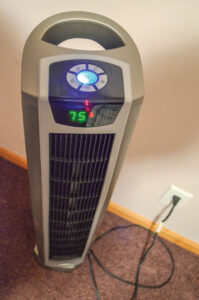During winter, for many of us, comfort at home means heat.
While a good central heating system is designed to meet whole house needs, sometimes consumers turn to space heaters for additional warmth. Some people use one to boost temperatures for a single room where the available heat is inadequate, but their widespread use, over extended periods, can boost winter heating bills.
“In some cases, small space heaters can be less expensive to use if you only want to heat one room or supplement inadequate heating in one room,” according to analysts at the U.S. Department of Energy (DOE). “However, a space heater is not necessarily an economical source of long-term warmth. It is not an alternative to a whole-home heating system.”
Right type for the job
According to DOE, two types of space heaters are generally available for the residential market.
Most can deliver between 10,000 Btu and 40,000 Btu of heat per hour and commonly run on electricity, propane, natural gas or kerosene. Wood and pellet stoves are also increasingly available for many applications.
Convective heating circulates air within an enclosed space, while radiant heating transfers warming energy directly to objects or people within close proximity to its source.
If central heating is unavailable or inadequate, a convective heating unit can distribute heat relatively evenly throughout an enclosed space. For garages, workshops, workout rooms or laundry areas, used for a few hours a day or each week, a convective heater could be a good fit.
Many convective electric heaters contain some type of sealed heat transfer liquid. They allow heat generated by the devices to store energy as heat, so they cycle less while providing consistent performance.
Radiant electric heaters typically include infrared heating elements. Nearby surfaces, including people absorb the heat. Air in immediate proximity to the unit’s enclosure or cabinetry also aids in the transfer of conductive warmth.
Safe not sorry

Space heaters get seasonal use, but they are responsible for 25,000 residential fires a year, according to the U.S. Consumer Product Safety Commission, which pegs the annual mortality rate at 300 a year. Burn injuries associated with surface contacts with room heaters send about 6,000 people to emergency rooms every year, and most of those incidents don’t result in fires.
Because the devices are designed to give off heat, they should always be set in locations clear of all flammable materials and out of reach of small children, pets or anyone with impaired mobility.
In recent years, many space heaters have been designed with tip-over safety features, which automatically shut off the power source in the event the unit tilts beyond its upright position.
Because space heaters are designed specifically to produce heat, they should be plugged directly into a wall whenever possible. If an extension cord is used, it should be heavy duty, and made of 14-gauge wire or larger.
Given a choice between high, medium and low, or an adjustable thermostat, choose the latter. A unit that heats your space to the desired temperature will cycle less, saving you energy, and never overheat the room.
And buy the right size heater for the right size space––too small and the warming results could be disappointing, too large or powerful and you’ll be uncomfortable. Any time you open doors or windows to vent away warm air, you are wasting energy you’ve already consumed to produce heat.
Getting more for less
 “Space heaters are not the ideal solution for heating homes,” said Brian Sloboda, a senior program manager for the National Rural Electric Cooperative Association. “For every unit of electricity that is consumed by these devices, they produce one unit of heat.”
“Space heaters are not the ideal solution for heating homes,” said Brian Sloboda, a senior program manager for the National Rural Electric Cooperative Association. “For every unit of electricity that is consumed by these devices, they produce one unit of heat.”
While adding several space heaters to supplement your central heating system is also likely to drive up your energy costs, selective use can help you save money.
According to analysts at the Environmental Protection Agency, the key is using space heaters in smaller rooms that are occupied infrequently, in conjunction with lower thermostat settings on your central system.
Lowering thermostat settings from 70 to 65 degrees and using a thermostat-controlled space heater to heat 10 percent of a home’s conditioned floor space will save a heat pump user $67 a year. But the EPA cautions that space heaters are most efficient when used in small spaces for limited periods and can actually waste energy if consumers try to heat too much area with the devices.
There are currently no space heaters among the EPA’s list of ENERGY STAR®-rated products. Agency officials said they have evaluated several models but have no plans to include such products in the labeling program in the near future.
Still, high-end space heaters are heavily marketed during the autumn and winter months.
“Most of these units are very similar in design, but the cabinetry or packaging, are major selling points,” said Sloboda. “Consumers should consider the wide range of heaters available, and their own taste in features and design before buying one.”
An energy expert can help determine if a space heater is right for your home.
“They may suggest other alternatives, like sealing air leaks, adding insulation or tuning up your heating system so it operates more efficiently,” said Sloboda. “Those are just a few of the options that won’t increase your overall energy use.”
Derrill Holly writes on consumer and cooperative affairs for the National Rural Electric Cooperative Association, the national trade association representing more than 900 local electric cooperatives. From growing suburbs to remote farming communities, electric co-ops serve as engines of economic development for 42 million Americans across 56 percent of the nation’s landscape.








